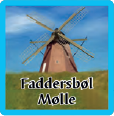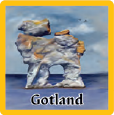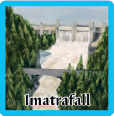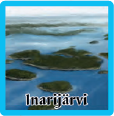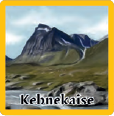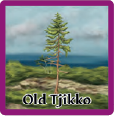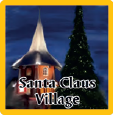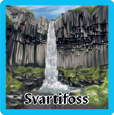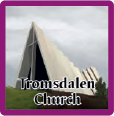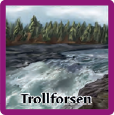Carcassonne: Landkaart - Scandinavië ...
De volken uit het noorden hebben altijd bekend gestaam om hun ontdekkingsreizen en hebben vele avonturen beleefd. Nu is het aan jullie om in hun voetstappen te treden.
Algemene informatie en opmerkingen
Carcassonne landkaart-fiches werd oorspronkelijk in 2019 uitgebracht door Hans im Glück.
Het is een mini-uitbreiding met verschillende spelregels voor elke Carcassonne Map. In het geval van Carcassonne Landkaarten - Scandinavië, kunnen de spelers een aantal Scandinavische bezienswaardigheden ontdekken en die met behulp van hun tegels gaan verkennen.
Speelmateriaal
- 30 landkaart-fiches (10 stuks in elk van de kleuren paars, lichtblauw, en oranje).
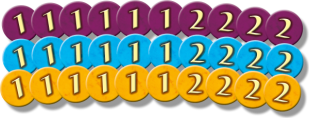
Carcassonne landkaart-fiches
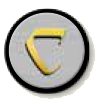
Achterkant landkaart-fiche
Het is aan te raden om met 115-125 tegels te spelen, m.a.w. uit de Big Box: Baisspel (72) + uitbr. 1 (18) + mini 4 t/m 7 (30) = 120 tegels.
Spelregels
Voorbereiding
Kies 2 van de 3 mogelijke start-vakken.
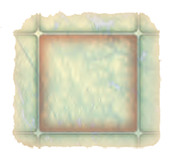
Voorbeeld: Startvak
Schud alle 30 landkaart-fiches gedekt en leg vervolgens twee ervan gedekt op elk gemarkeerd vak.
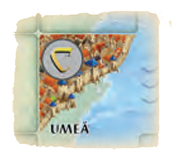
Voorbeeld: Vak voor twee landkaart-fiches
Spelverloop
Golven
Er staan vakken met golven op de landkaart. Op deze vakken mag je geen landtegel aanleggen.
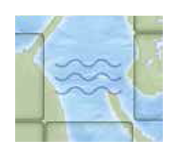
Voorbeeld: Een vak met golven, waar geen tegel aangelegd mag worden.
Fiches verzamelen
Als je een tegel aanlegt naast een voorbedrukte stad, neem je onmiddellijk de landkaart-fiches die daar liggen. Het maakt niet uit of je wel of neit een meeple zet. Je krijgt direct het aantal punten dat door de getallen op de landkaartfiches wordt aangegeven. Hierna neem je de fiches in voorraad.
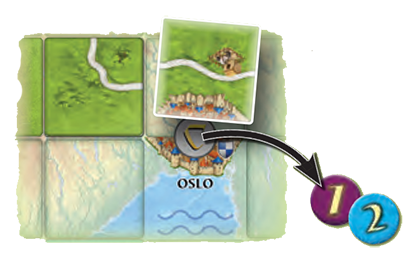
Voorbeeld 1: Je legt jouw tegel naast Oslo aan. Je krijgt 2 landkaart-fiches die 3 punten waard zijn.
Scandinavische bezienswaardigheden ontdekken
Je mag geen landtegel op een bezienswaardigheid aanleggen. Maar je mag wel een willekeurige tegel ernaast aanleggen. Net als bij een randvak, worden alle projecten aan de kant van de bezienswaardigheid afgesloten. Als een bezienswaardigheid aan één kant ontdekt is, mag je niet automatisch ook aan de andere zijden tegels aanleggen (in tegenstelling tot een voorbedrukte stad).
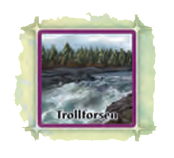
Voorbeeld 2: Scandinavische bezienswaardigheid
After having placed a tile you are allowed to place a meeple according to the general rules.
If you are scoring a road, you can upgrade it, by using your map-chips. For every color you use, you get 1 additional point per tile. You can use 1 chip per color per scoring. Afterward, the used chips are removed from the game.
Every highlight is bordered with one of the 3 map-chip colors. Because of that, you will get 2 instead of 1 point for each tile of a road to a highlight.
If you use map-chips with other colors, you get 1 more point per color for each road tile. The colors which border the highlight can be used several times.
The ferry routes are counted, independent from their length, as 1 road tile and can be improved by map-chips as usual.
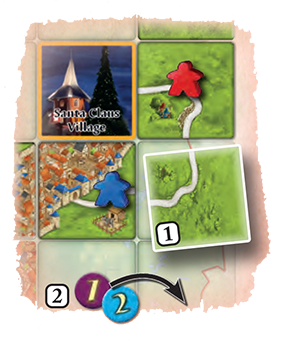
Example:
1 You close the road to Santa Claus Village.
2 You use a light blue and a purple chip, to have all 3 colors (the village is bordered by orange, so you don't need an orange chip).
Because you have 3 different colors, each road tile is now worth 4 points for you. You get 12 points total for this road.
Since Blue is also on this road, but didn't use any chips, Blue only gets 2 points per tile, so 6 points total.
Final scoring
At the end of the game, you can't upgrade any of your roads, neither with chips nor by the highlights.
Tile distribution
The highlights
Faddersbøl Mølle is a so-called Holland mill, which, as the name suggests, was developed in Holland. The mill was built in 1859. Today, the landscape is shaped by the many high windmills in this area. The mill was used by the farmers of this area to grind their grain.
Gotland is a Swedish island and historical province. It’s the second-largest island in the Baltic Sea. The island got its name from the German tribe of the “Goths”. Today Gotland is a famous holiday destination. Gotland is known for its species-rich natural landscape. Especially the birdlife and the diversity of orchids are to be highlighted.
The Imatrafall is a waterfall in the city Imatra. The Vuoksi river falls here, over 500 meters, in a narrow granite canyon 18 meters deep. Since 1929 the falls are used for energy production and the water redirected. Only at certain times, the locks are opened, and the old river gets flooded. The Imatrafall is one of 27 official “nature landscapes” of Finland.
Inarijärvi is a lake in the Lapland part of Finland. The lake is the third-largest lake in Finland. The deepest point of the lake is 92 meters deep. Because of its more than 3000 islands, it seems like a labyrinth of water roads, instead of a stretch of water.
The Kebnekaise, at 2097 meters tall (north peak), is the highest mountain of Sweden. Previously the glaciated south peak was higher than the north peak, but in 2018 because of glacial melt, the south peak became smaller than the north peak.
Old Tjikko is an approximately 9550-year-old Norway spruce, which grows in the mountains of the Swedish province Dalarna. Old Tjikko is the oldest living individual clonal tree. The stem gets estimated at some hundred years. The tree as a whole, survived much longer, by regrowing a new stem, from the still-living root system.
Santa Claus Village is an amusement park in Rovaniemi, in the Lapland part of Finland. It was opened in 1985. In the middle of the village is a white line showing the arctic circle from 1865. Today the arctic circle is about 700m further north. Santa Claus has an office in the village, where you can meet him during his office hours.
The Svartifoss, in English “black waterfall”, because of the color of the surrounding rocks, is at Skaftafell national park in the southeast of Iceland. Der Stórilækur (big creek) falls over a rock edge, which is surrounded by basalt columns like organ pipes, and keeps flows in the Vestragil (west canyon).
The Tromsdalen Church (also called Arctic Cathedral) is an Evangelical Lutheran Parish, Seaman's Church, and a Tromsø city landmark. The cathedral was created by the architect Jan Inge Hovig and built from 1964 to 1965.
Trollforsen is one of the biggest rapids in Europe. It’s in the Norway community Arvidsjaur. For a distance of 800m, the Piteälven river flows between rocks and over cliffs and overcomes a considerable difference in altitude. The nature forest around is full of creeks, little lakes, and swamps.














